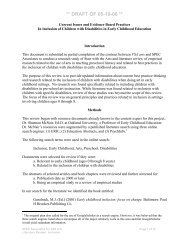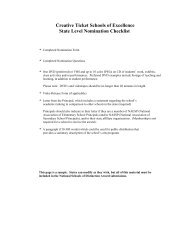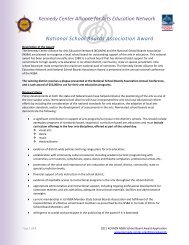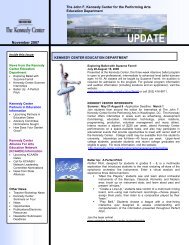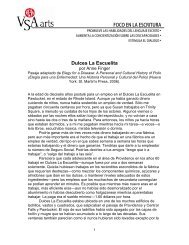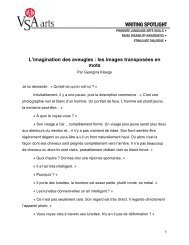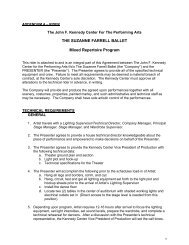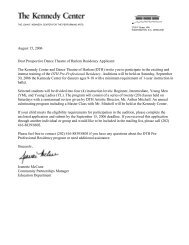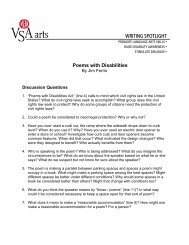Playwright Discovery Award Teacher's Guide - The John F. Kennedy ...
Playwright Discovery Award Teacher's Guide - The John F. Kennedy ...
Playwright Discovery Award Teacher's Guide - The John F. Kennedy ...
Create successful ePaper yourself
Turn your PDF publications into a flip-book with our unique Google optimized e-Paper software.
FOR THE ARTIST’S NOTEBOOK:<br />
<strong>The</strong> Building Blocks of a Play<br />
<strong>The</strong> Root of Character<br />
For a dynamic play, the characters need to be<br />
different from the writer and from each other. A<br />
good starting point may be to observe friends<br />
or strangers in conversation and in action. How<br />
are they different from each other? Just as<br />
important, how are they the same? What sorts<br />
of obstacles might keep us from seeing those<br />
similarities? <strong>The</strong>ir clothing? <strong>The</strong>ir speech? Also<br />
consider how these characters might change<br />
as the situation changes. To begin imagining<br />
well-grounded, believable characters, a writer<br />
conducts research. That research—learning<br />
about the characters and their world—can come<br />
through reading, observing, or thinking about<br />
your own experiences.<br />
<strong>The</strong> Other Building Blocks of a<br />
Play Are:<br />
<strong>The</strong> Main Character <strong>The</strong> person the audience<br />
follows to understand the bulk of the story. This<br />
figure confronts most of the play’s challenges<br />
and conflicts. A successfully crafted Main<br />
Character changes or transforms somehow after<br />
a moment of crisis. It is also possible for a play<br />
to be more ensemble-based and have more<br />
than one main character. However, the major<br />
characters should still change over the course of<br />
the play.<br />
<strong>The</strong> Dramatic Problem This is the set-up or<br />
question that the Main Character (or characters)<br />
must confront and solve. It should not be easy<br />
for the Main Character to address the problem.<br />
Initially, it may appear easy, but something<br />
should happen along the way to complicate the<br />
problem and create a challenge that will cause<br />
the Main Character to grow and change.<br />
Need or Want This is what the Main Character<br />
(or characters) must have or wishes to attain.<br />
<strong>The</strong> Need can be tangible (a ride to school,<br />
an A on a test, money to download songs) or<br />
an intangible, emotional want (to be accepted<br />
by a group of kids, to be loved by a parent).<br />
Whatever it is, it must be important to the<br />
character.<br />
<strong>The</strong> Stakes This tells the character and<br />
audience how important the Dramatic Problem<br />
and Need are and adds great tension to the play<br />
or scene. Another way to think of the stakes<br />
is to ask, “What bad thing will happen to my<br />
character if she or he doesn’t get what she or he<br />
needs?”<br />
<strong>The</strong> Ticking Clock Time can be used to<br />
create tension in a play by raising the stakes and<br />
intensifying the obstacles. Something must be<br />
completed by a set time, and often something<br />
bad will happen if that deadline is missed.<br />
<strong>The</strong> What Ifs <strong>The</strong>se are the questions that<br />
writers ask to discover and then weave the<br />
elements of Character, Dramatic Problem, Need,<br />
and the Stakes into a compelling scene or play.<br />
A Beat This is the smallest unit of action in a<br />
play, defined by characters having a particular<br />
objective or intention; a beat shifts when the<br />
character’s intention or attempts to achieve an<br />
objective changes.<br />
A Scene This is a unit of a play and is made up<br />
of beats.<br />
ACT II: PLAYWRITING 19



